| Visiting Scientists |

|

Dr. Amelia Cristina Montoya-Martínez received her Ph.D. in 2019 under the guidance of Drs. Gerardo Rodríguez-Alvarado and Sylvia P. Fernández-Pavía at the Universidad Michoacana de San Nicolás de Hidalgo in Morelia-Zinapécuaro, Michoacán, Mexico. During her Ph.D. studies, Cristina joined the Mycotoxin Prevention & Applied Microbiology (MPM) research unit in August 2018 as a visiting scientist fully funded for 6 months by the Consejo Nacional de Ciencia y Tecnología (CONACYT). Working with Dr. Kerry O’Donnell, and several other MPM scientists, Cristina conducted phylogenetic analyses of DNA sequence data to identify Fusarium species associated with malformation disease of neotropical trees and symptomless weeds in commercial mango orchards in Mexico. In addition, Cristina used whole-genome sequence data to design and validate a robust molecular diagnostic assay that accurately identifies mating type of isolates within the agronomically important Fusarium fujikuroi species complex.
Montoya-Martínez AC, Rodríguez-Alvarado G, Fernández-Pavía SP, Proctor RH, Kim H-S, O’Donnell K. 2019. Design and validation of a robust multiplex polymerase chain reaction assay for MAT idiomorph within the Fusarium fujikuroi species complex. Mycologia 111:772–781.
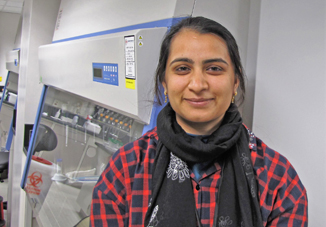
Hina Shanakhat, a Ph.D. student in Agriculture and Food Sciences at the University of Naples Federico II (Italy) joined the Mycotoxin Prevention & Applied Microbiology research unit as a visiting scientist in October 2018. Working with Dr. Matthew Bakker and other personnel at the National Center for Agricultural Utilization Technology, Hina is investigating microbial strains and enzymes that are able to chemically modify the mycotoxin deoxynivalenol. This research is part of a larger project that aims to reduce the economic impact of Fusarium head blight and the mycotoxins that are associated with this plant disease.

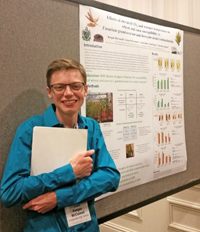

Three MPM Scientists Receive Summer Internship Awards to Support Student Research
The Midwest Area Summer Internship Program is a competitive award program that provides funding for undergraduate students to obtain meaningful work experience in a scientific, professional, or technical field. The goal of this program is to promote interest in science and in future career opportunities with ARS. Internship proposals written by three MPM scientists were selected for funding in 2018. As a result, Ms. Ashley Silver (a Biology major at the University of Tulsa) is working with Dr. Guixia Hao on a project to characterize virulence proteins from Fusarium graminearum; Mr. Keegan McConnell (a Biology major at Southern Illinois University) is working with Dr. Martha Vaughan on a project to determine how elevated CO2 and warmer temperature will affect wheat and corn susceptibility to Fusarium graminearum and mycotoxin contamination; and Ms. Kelsey Roberts (a Microbiology major at Western Illinois University) is working with Dr. Matt Bakker on a project to investigate colonization of wheat plants by endophytic fungi.
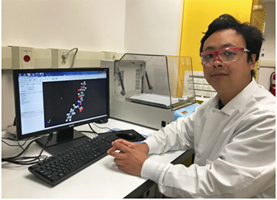
Dr. Yi-Shu Tu is a post-doctoral researcher supported by the Taiwanese Ministry of Science and Technology and joined the Mycotoxin Prevention and Applied Microbiology Research Unit for one year to improve mycotoxin detection using quantum chemical methods and spectroscopy. Working with Dr. Michael Appell, Yi-Shu applied quantum dynamics methods that explain the selective detection properties associated with the Infrared and Raman fingerprint regions of ochratoxins and other mycotoxins. In further studies, Dr. Tu developed descriptive models for trichothecene toxicity using cheminformatic methods. Dr. Tu holds a Ph.D. in Biomedical Electronics and Bioinformatics from National Taiwan University.
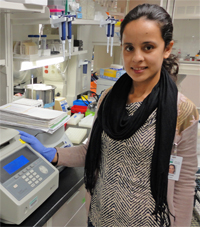
Dr. Imane Laraba joined the Mycotoxin Prevention & Applied Microbiology (MPM) research unit as a visiting scientist in March 2018. Imane completed her Ph.D. studies focusing on Fusarium head blight (FHB) and crown rot (FCR) diversity in Algeria at the École Nationale supérieure Agronomique, Algiers under the direction of Dr. Houda Boureghda in 2018. Some of her dissertation research, with support from the Algerian Ministry of Higher Education and Scientific Research, was conducted with Dr. Kerry O’Donnell and several other MPM scientists. This research led to peer-reviewed publications on the population genetics and mycotoxin potential of Fusarium culmorum, the most important FHB and FCR pathogen in Algeria and the discovery and characterization of F. algeriense, a novel FCR pathogen (see below). Imane’s current research in the MPM Research Unit, which is funded by USDA-ARS National Program for Food Safety and NSF DEB-1655980, is focused on characterizing the genetic diversity and trichothecene mycotoxin potential of the most important group of fusaria pathogenic to cereals, the F. sambucinum species complex, and a novel species, F. xyrophilum, which induces pseudoflowers on two perennial Xyris species.
Laraba I, Boureghda H, Abdallah N, Bouaicha O, Obanor F, Moretti A, Geiser DM, Kim H-S, McCormick SP, Proctor RH, Kelly AC, Ward TJ, O'Donnell K. 2017. Population genetic structure and mycotoxin potential of the wheat crown rot and head blight pathogen Fusarium culmorum in Algeria. Fungal Genetics and Biology 103:34–41.
Laraba I, Keddad A, Boureghda H, Abdallah N, Vaughan MM, Proctor RH, Busman M, O’Donnell K. 2018. Fusarium algeriense, sp. nov., a novel toxigenic crown rot pathogen of durum wheat from Algeria is nested in the Fusarium burgessii species complex. Mycologia 109:935–950.
Laraba I, Kim H-S, Proctor RH, Busman M, O’Donnell K, Felker FC, Aime MC, Koch RA, Wurdack KJ. 2019. Fusarium xyrophilum, sp. nov., a member of the Fusarium fujikuroi species complex recovered from pseudoflowers on yellow-eyed grass (Xyris spp.) from Guyana. Mycologia DOI:10.1080/00275514.

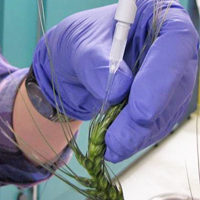
Briana Whitaker, a PhD candidate in the Department of Biology at Indiana University-Bloomington, joined the Mycotoxin Prevention & Applied Microbiology (MPM) research unit for an internship experience during the fall of 2017 and spring of 2018. Working with Dr. Matthew Bakker, Briana explored the communities of bacteria inhabiting internal wheat tissues, and tested the ability of these bacteria to limit the growth of the fungus that causes Fusarium head blight in wheat. Of her experiences at USDA ARS, Briana says, “It has been amazing to work with some of the world's top experts on such a debilitating disease of crops in the United States. I have gained new perspectives on the importance of collaboration with crop scientists and land managers for solving problems such as these.” An interagency agreement enables the Agricultural Research Service to host awardees, like Briana, of the National Science Foundation’s Graduate Research Internship Program.
Briana K Whitaker, Matthew G Bakker; Bacterial endophyte antagonism toward a fungal pathogen in vitro does not predict protection in live plant tissue, FEMS Microbiology Ecology, Volume 95, Issue 2, 1 February 2019, fiy237, https://doi.org/10.1093/femsec/fiy237

Dr. Carolina Bertuzzi Pereira completed her Ph.D. studies in 2019 under the guidance of Dr. Dauri José Tessmann at the State University of Maringá in Brazil. During her Ph.D. studies, Carolina joined the Mycotoxin Prevention & Applied Microbiology research unit as a visiting scientist funded by a “sandwich-semester” grant from the Brazilian Ministry of Education. Working with Dr. Todd Ward and several other MPM scientists during her six-month visit in 2017, Carolina characterized species diversity, population structure, and mycotoxin production among Fusarium head blight pathogens of wheat and barley in Paraná State, Brazil. This research is part of an international collaborative project aimed at understanding the global distribution, movement and ecology of fungi responsible for billion-dollar annual losses to cereal crop production worldwide. In addition, Carolina discovered and characterized a novel toxigenic species, F. subtropicale, which was isolated from barley (Hordeum vulgare) in Brazil.
Pereira CB, Ward TJ, Tessmann DJ, Del Ponte EM, Laraba I, Vaughan MM, McCormick SP, Busman M, Kelly A, Proctor RH, O’Donnell K. 2018. Fusarium subtropicale, sp. nov., a novel nivalenol mycotoxin–producing species isolated from barley (Hordeum vulgare) in Brazil and sister to F. praegraminearum Mycologia 110:860–871.
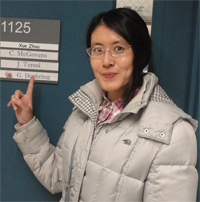
Dr. Xue Zhou received her Ph.D. under the guidance of Dr. Zhi-Min Cao at the Northwest A&F University in Yangling, China in 2019. Xue joined the Mycotoxin Prevention & Applied Microbiology (MPM) research unit in December 2017 as a visiting scientist fully funded for one year by the China Scholarship Council. Working with Dr. Kerry O’Donnell, and several other MPM scientists, Xue used whole-genome sequence data and laboratory crosses to characterize the sexual reproductive mode of three canker-inducing tree pathogens, including two closely related species linked to the decline of prickly ash (= Sichuan pepper) in northern China. Xue and Dr. Hye-Seon Kim mined the complete mitochondrial genomes of the parents used in these crosses to develop molecular markers to investigate mitochondrial inheritance in the two Sichuan pepper pathogens. Xue’s research was published in the following peer-reviewed publications.
Zhou X, Cao Z-M, Liu X, Kim H-S, Proctor RH, O’Donnell K. 2019. Maternal mitochondrial inheritance in two Fusarium pathogens of prickly ash (Zanthoxylum bungeanum) in northern China. Mycologia 111:235–243.
Zhou X, O’Donnell K, Kim H-S, Proctor RH, Doehring G, Cao Z-M. 2018. Heterothallic sexual reproduction in three canker-inducing tree pathogens within the Fusarium torreyae species complex. Mycologia 110:710–725.

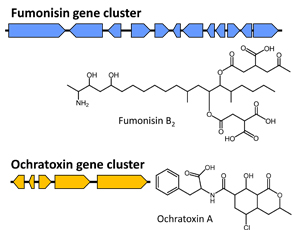
Dr. Antonia Susca is a senior scientist at the Institute of Sciences of Food Production in Bari, Italy, and joined the Mycotoxin Prevention & Applied Microbiology research unit as a visiting scientist in May 2017. Her three-week visit was funded by a short-term fellowship program sponsored by the National Research Council of Italy. Working with Dr. Robert Proctor and other MPM personnel, Dr. Susca conducted genomic analyses of species of the fungi Aspergillus and Fusarium that are of concern to food and feed safety because of their ability to produce mycotoxins. This collaborative research has provided important insights into the genetic bases for differences in mycotoxin production that exist within species of Aspergillus and Fusarium.
Susca et al. 2016. Variation in fumonisin and ochratoxin production associated with differences in biosynthetic gene content in Aspergillus niger and A. welwitschiae isolates from multiple crop and geographic origins. Frontiers in Microbiology 7:1-15


Dr. Santiago Gutierrez, a professor at the University of León-Ponferrada in Spain, joined the Mycotoxin Prevention & Applied Microbiology research unit as a visiting scientist in the autumn of 2016. His three-month visit was funded by the Spanish Ministry of Economy and Competitiveness. Working with Drs. Robert Proctor and Susan McCormick as well as other MPM personnel, Professor Gutierrez characterized multiple genes required for synthesis of trichothecenes, a group of fungal metabolites that are among the mycotoxins of greatest concern to food and feed safety. His research was part of an international collaboration aimed at understanding the evolutionary processes that have given rise to the tremendous diversity in structure and biological activity of trichothecenes. His findings provide key insight into how the activities of enzymes have changed over time to give rise to the different trichothecene structures produced by fungi.
Proctor et al. 2018. Evolution of structural diversity of trichothecenes, a family of toxins produced by plant pathogenic and entomopathogenic fungi. PLoS Pathogens 14:e1006946
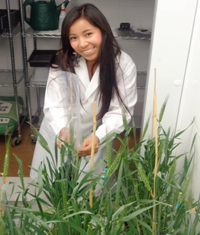
Minely Cerón Bustamante, a M.S. student under the guidance of Dr. Cristian Nava-Diaz at the Colegio de Postgraduado in Mexico, joined the Mycotoxin Prevention & Applied Microbiology research unit as a visiting scientist funded by a grant from the National Council of Science and Technology, Mexico. Working with Dr. Todd Ward and several other MPM scientists during her three-month visit in 2015, Minely analyzed regional differences in species diversity, mycotoxin potential, and aggressiveness toward wheat among FHB pathogens. Minely’s research led to two peer-reviewed publications, contributed to her M.S. thesis, and is part of an international collaborative project to understand the global distribution, movement and ecology of fungi responsible for billion dollar annual losses to cereal crop production worldwide.
Ceron, Bustamante et al. (2016) First report of F. meridionale causing Fusarium Head Blight of wheat in Mexico. Plant Disease. 100:1790.
Cerón-Bustamante et al. (2018) Regional differences in the composition of Fusarium head blight pathogens and mycotoxins associated with wheat in Mexico. International Journal of Food Microbiology. 273:11-19.
